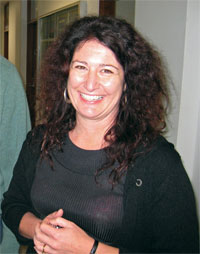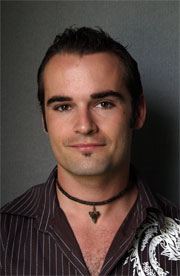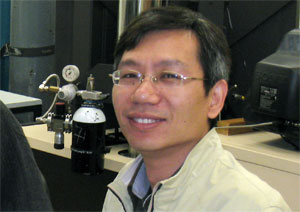GEMOC participants
GEMOC is based at Macquarie University (in the Department of Earth and Planetary Sciences).There is active collaboration with state Geological Surveys, GA (Geoscience Australia), CSIRO, ANU/RSES and several major industry concerns, across a broad range of projects.
Collaborative research, teaching and technology development links have been established with other universities nationally and internationally and these evolve as new alliances become relevant to new directions.
GEMOC has developed ongoing collaborative relationships with national and international industry and end-users such as Geological Surveys globally (eg some Australian states, Canada, Norway).
GEMOC has a wide network of international research and teaching development partners and collaborators.
A full list of GEMOC participants and their affiliations is given in Appendices 1 and 3
CHANGES IN 2007

Appointments in the EAPE CoRE
Professor William Griffin was appointed to the EAPE CoRE in March 2007. His research deals primarily with the petrology and geochemistry of the lower crust and upper mantle in the context of integrating petrology with geophysics and tectonics to solve large-scale problems including the formation and modification of continents, and Earth evolution. His techniques for target evaluation in diamond exploration, using the trace-element chemistry of mantle-derived minerals, are now widely adopted by the industry and continue to provide a focus for interaction with the industry. This 4-D Lithosphere Mapping technique became the basis for mapping the composition, structure and thermal state of the lithospheric mantle, and the recognition of its secular/episodic evolution. Previously seconded to GEMOC from CSIRO, he leads the Industry Interaction Program and the Technology Development Program, which has made breakthroughs including the Re-Os dating of sulfide minerals and the integrated U-Pb/Hf-isotope analysis of detrital zircons for analysis of crustal evolution. Since 2002 he has worked closely with WMCR (later BHPB) staff developing new interpretative techniques to integrate petrology, tectonics, geochemistry and geophysics.


Dr Craig O’Neill is an early-career researcher with an already established track record in innovative approaches to geodynamic modelling. He uses numerical models of mantle convection to understand the dynamics of plate tectonic systems, and the conditions under which plate tectonics breaks down. These models address the tectonic regime of the early Earth, and melt generation and crustal production in chaotic mantle convection regimes, with the view to understanding the formation and evolution of the continental lithosphere and its mantle environment.
Other new arrivals

Dr Christoph Beier joined GEMOC in March 2007 as a 2-year Feodor-Lynen Research Fellow of the Alexander von Humboldt-Foundation. Christoph is primarily interested in understanding mantle heterogeneity and melting processes beneath ocean islands, mid-ocean ridges and subduction zones by means of major elements, trace elements, radiogenic isotopes and short-lived U-series isotopes. His specific research areas of recent interest are the short-lived U-series isotopes along the East Pacific Rise, in the Azores archipelago and in the Manus Basin. The goal of these studies is to establish a model of the impact of mantle heterogeneity on mantle melting.

Dr Mei-Fei Chu commenced at GEMOC in October 2007 as a Research Associate to develop the methodology for Li isotopic analysis in whole-rocks and apply this isotopic tool to understanding the genesis of crustal melts and the role of recycled components in mantle processes. Dr Chu was awarded her PhD at the National Taiwan University (NTU) in 2006. Her PhD research included setting up the first LA-ICPMS system in the Department of Geosciences, NTU and the application of LA-ICPMS geochemical results to the study of Trans-Himalayan petrogenesis by using trace-element abundances of apatite and isotopic compositions of zircon from different types of intrusive rocks in the Lhasa terrane, southern Tibet.
 Dr Jinhui Yang, Professor of Geochemistry, from the State Key Laboratory of Lithospheric Evolution, Institute of Geology and Geophysics, Chinese Academy of Sciences, was awarded a Research Fellowship from the Chinese Academy of Sciences to undertake research for one year in GEMOC. During 2007 he worked on the nature of the mantle beneath North Korea using mantle xenoliths from kimberlites, and on Mesozoic magmatism related to lithospheric thinning in the eastern North China Craton. He published, among others, an important paper in Geology re-emphasising that the “North China craton” is no longer a craton, and coined the term “decratonisation” to refer to this process. Planned future collaborative research and joint PhD supervision will strengthen this link between GEMOC and the geochemical area of the Chinese Academy of Sciences.
Dr Jinhui Yang, Professor of Geochemistry, from the State Key Laboratory of Lithospheric Evolution, Institute of Geology and Geophysics, Chinese Academy of Sciences, was awarded a Research Fellowship from the Chinese Academy of Sciences to undertake research for one year in GEMOC. During 2007 he worked on the nature of the mantle beneath North Korea using mantle xenoliths from kimberlites, and on Mesozoic magmatism related to lithospheric thinning in the eastern North China Craton. He published, among others, an important paper in Geology re-emphasising that the “North China craton” is no longer a craton, and coined the term “decratonisation” to refer to this process. Planned future collaborative research and joint PhD supervision will strengthen this link between GEMOC and the geochemical area of the Chinese Academy of Sciences.

 GEMOC ARC National Key Centre
GEMOC ARC National Key Centre